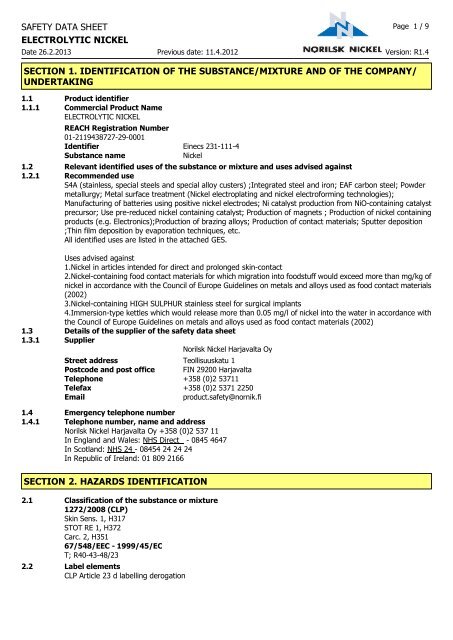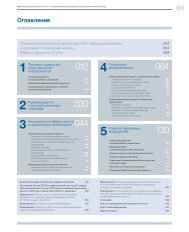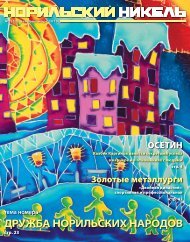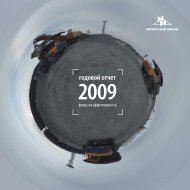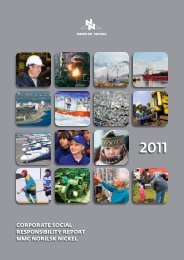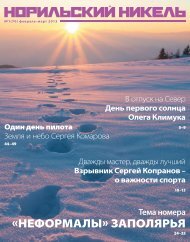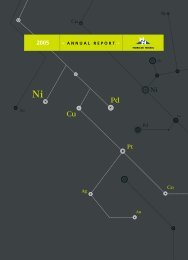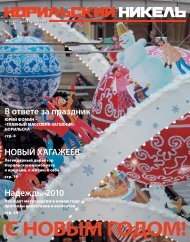Norilsk Nickel Harjavalta
Norilsk Nickel Harjavalta
Norilsk Nickel Harjavalta
Create successful ePaper yourself
Turn your PDF publications into a flip-book with our unique Google optimized e-Paper software.
SAFETY DATA SHEET Page 1 / 9ELECTROLYTIC NICKELDate 26.2.2013 Previous date: 11.4.2012 Version: R1.4SECTION 1. IDENTIFICATION OF THE SUBSTANCE/MIXTURE AND OF THE COMPANY/UNDERTAKING1.1 Product identifier1.1.1 Commercial Product NameELECTROLYTIC NICKELREACH Registration Number01-2119438727-29-0001Identifier Einecs 231-111-4Substance name<strong>Nickel</strong>1.2 Relevant identified uses of the substance or mixture and uses advised against1.2.1 Recommended useS4A (stainless, special steels and special alloy custers) ;Integrated steel and iron; EAF carbon steel; Powdermetallurgy; Metal surface treatment (<strong>Nickel</strong> electroplating and nickel electroforming technologies);Manufacturing of batteries using positive nickel electrodes; Ni catalyst production from NiO-containing catalystprecursor; Use pre-reduced nickel containing catalyst; Production of magnets ; Production of nickel containingproducts (e.g. Electronics);Production of brazing alloys; Production of contact materials; Sputter deposition;Thin film deposition by evaporation techniques, etc.All identified uses are listed in the attached GES.Uses advised against1.<strong>Nickel</strong> in articles intended for direct and prolonged skin-contact2.<strong>Nickel</strong>-containing food contact materials for which migration into foodstuff would exceed more than mg/kg ofnickel in accordance with the Council of Europe Guidelines on metals and alloys used as food contact materials(2002)3.<strong>Nickel</strong>-containing HIGH SULPHUR stainless steel for surgical implants4.Immersion-type kettles which would release more than 0.05 mg/l of nickel into the water in accordance withthe Council of Europe Guidelines on metals and alloys used as food contact materials (2002)1.3 Details of the supplier of the safety data sheet1.3.1 Supplier<strong>Norilsk</strong> <strong>Nickel</strong> <strong>Harjavalta</strong> OyStreet address Teollisuuskatu 1Postcode and post office FIN 29200 <strong>Harjavalta</strong>Telephone +358 (0)2 53711Telefax +358 (0)2 5371 2250Emailproduct.safety@nornik.fi1.4 Emergency telephone number1.4.1 Telephone number, name and address<strong>Norilsk</strong> <strong>Nickel</strong> <strong>Harjavalta</strong> Oy +358 (0)2 537 11In England and Wales: NHS Direct - 0845 4647In Scotland: NHS 24 - 08454 24 24 24In Republic of Ireland: 01 809 2166SECTION 2. HAZARDS IDENTIFICATION2.1 Classification of the substance or mixture1272/2008 (CLP)Skin Sens. 1, H317STOT RE 1, H372Carc. 2, H35167/548/EEC - 1999/45/ECT; R40-43-48/232.2 Label elementsCLP Article 23 d labelling derogation
SAFETY DATA SHEET Page 2 / 9ELECTROLYTIC NICKELDate 26.2.2013 Previous date: 11.4.2012 Version: R1.41272/2008 (CLP)GHS07 - GHS08Signal word DangerHazard StatementsH317May cause an allergic skin reaction.H372Causes damage to lungs through prolonged or repeated exposure by inhalation.H351_Suspected of causing cancer via inhalation.Precautionary StatementsP202Do not handle until all safety precautions have been read and understood.P281Use personal protective equipment as required.P261Avoid breathing dust/fume/gas/mist/vapours/spray.P333+P313 If skin irritation or rash occurs: Get medical advice/attention.2.3 Other hazardsThe PBT and vPvB criteria of Annex XIII to the regulation does not apply to inorganic substances.SECTION 3. COMPOSITION/INFORMATION ON INGREDIENTSHazardous componentsCAS/EC and EINECS Chemical name of the Concentration ClassificationReg.numbersubstance7440-02-0 231-111-4 <strong>Nickel</strong> 99,9% SECTION 2.1SECTION 4. FIRST AID MEASURES4.1 Description of first aid measures4.1.2 InhalationRemove affected person from the immediate area. Ensure supply of fresh air. If breathing is irregular orstopped, administer artificial respiration. Consult a physician.4.1.3 Skin contactWash off with soap and plenty of water. Remove soiled or soaked clothing immediately. Wash contaminatedclothing before re-use.4.1.4 Eye contactRinse immediately with plenty of water, also under the eyelids, for at least 15 minutes. If eye irritation persists,consult a specialist.4.1.5 IngestionRinse mouth. Consult a physician.4.2 Most important symptoms and effects, both acute and delayedTreat symptomatically.4.3 Indication of immediate medical attention and special treatment neededNo hazards which require special first aid measures.SECTION 5. FIREFIGHTING MEASURES5.1 Extinguishing media5.1.1 Suitable extinguishing mediaThe product itself does not burn. Use extinguishing measures that are appropriate to local circumstances andthe surrounding environment e.g.: Dry powder; Carbon dioxide (CO2); Water spray jet; Foam;5.1.2 Extinguishing media which must not be used for safety reasonsNot applicable.5.2 Special hazards arising from the substance or mixtureIn the event of fire the following can be released: Metallic oxides;5.3 Advice for firefightersWear self-contained breathing apparatus and protective suit.
SAFETY DATA SHEET Page 3 / 9ELECTROLYTIC NICKELDate 26.2.2013 Previous date: 11.4.2012 Version: R1.45.4 Specific methods<strong>Nickel</strong> is non-flammable, but very fine nickel particles can burn.SECTION 6. ACCIDENTAL RELEASE MEASURES6.1 Personal precautions, protective equipment and emergency proceduresRefer to protective measures listed in sections 7 and 8. Avoid contact with skin, eyes and clothing. Ensureadequate ventilation.6.2 Environmental precautionsDo not discharge into the drains/surface waters/groundwater.6.3 Methods and materials for containment and cleaning upPick up mechanically. Send in suitable containers for recovery or disposal. (Section 13)6.4 Reference to other sectionsSee also section 8,13SECTION 7. HANDLING AND STORAGE7.1 Precautions for safe handlingTake note of Directive 98/24/EC on the protection of the health and safety of workers from the risks related tochemical agents at work.Safe handling adviceAvoid contact with skin, eyes and clothing. If workplace exposure limits are exceeded, respiratory protectionapproved for this particular job must be worn.Technical measures/PrecautionsProvide good ventilation of working area (local exhaust ventilation if necessary).7.2 Conditions for safe storage, including any incompatibilitiesAlways keep in containers of same material as the original one. Keep containers tightly closed in a dry, cool andwell-ventilated place.Oxidizing agents; Reacts with acids to form flammable/explosive hydrogen gases.7.3 Specific end use(s)Exposure scenario is attached. Genric exposure scenario available from:http://www.nickelconsortia.org/exposure-scenario-library.htmlSECTION 8. EXPOSURE CONTROLS/PERSONAL PROTECTION8.1 Control parameters8.1.1 Threshold limits7440-02-0 <strong>Nickel</strong>1 mg/m 3 (8 h)Ni HTP 2012 Finland)8.1.4 DNELs
SAFETY DATA SHEET Page 4 / 9ELECTROLYTIC NICKELDate 26.2.2013 Previous date: 11.4.2012 Version: R1.48.1.5 PNECsWorkersRoute/Descriptors [corrected] /DNEL/DMELAcute-systemic effectsInhalation (mg Ni/m3)/ NOAEC = 12,000/ DNEL = 680, (MMAD
SAFETY DATA SHEET Page 5 / 9ELECTROLYTIC NICKELDate 26.2.2013 Previous date: 11.4.2012 Version: R1.4RISK VALUES: EnvironmentCompartmentCategory / Threshold Value/ Relative Absorption Factor (RAF)/ Assessment Factor (AF) / PNEC/Comment ValueAquaticFreshwater/ 7.2 ug Ni/L (HC5) /Not relevant /2 /3.6 ug Ni/L /Bioavailability correction availableMarine /17.2 ug Ni/L (HC5) /Not relevant /2 /8.6 ug Ni/L /No bioavailability correction availableSedimentFreshwater/ Pending outcome of testing program/Not relevant /Pending outcome of testing program/Pendingoutcome of testing program/Pending outcome of testing programMarine /Pending outcome of testing program/Not relevant /Pending outcome of testing program/Pending oftesting programTerrestrial / Soil /59.8 mg Ni/kg (HC5) /Not relevant /2 /29.9 mg Ni/kg /Based on10th percentile of abiotic soilpara-meters in EU. Bioavaila-bility correction availableSewage Treatment Plant (STP) /Microbial activity 33 mg Ni/L (Lowest NOEC) /Not relevant /100 /0.33 mgNi/LSecondary Poisoning: AquaticOystercatcher (aquatic bird) 123 mg Ni/kg /1 /10 /12.3 mg Ni/kgEuropean otter (freshwater-mammalian) 23 mg Ni/kg /0,025 /10 /2.3 mg Ni/kgHarbor seal (marine mammalian) 46 mg Ni/kg /0,025 /10 /4.6 mg Ni/kgSecondary Poisoning: TerrestrialEarthworm eating bird 85 mg Ni/kg /1 /10 /8.5 mg Ni/kgShrew (terrestrial mammalian) 1.2 mg Ni/kg /0.036 (100% worms) /10 /0.12 mg Ni/kg0.025 (30% worms, 70% isopods)8.2 Exposure controls8.2.1 Appropriate engineering controlsAvoid contact with skin and eyes. Do not breathe dust. Avoid repeated exposure. Wear suitable protectiveequipment. Ensure that eyewash stations and safety showers are close to the workstation location. Removesoiled or soaked clothing immediately. Clean skin thoroughly after work. At work do not eat, drink, smoke ortake drugs. Keep away from food, drink and animal feedingstuffs. Keep working clothes separately.8.2.2.1 Respiratory protectionUse a respirator with filter model P3 (DIN 3181).8.2.2.2 Hand protectionProtective gloves: Leather;8.2.2.3 Eye/face protectionFace-shield;8.2.2.4 Skin protectionClothing as usual in the chemical industry.8.2.3 Environmental exposure controlsThe employer shall fulfill requirements of IPPC Directive.SECTION 9. PHYSICAL AND CHEMICAL PROPERTIES9.1 Important Health Safety and Environmental Information9.1.1 Appearance Appearance: SolidColour: Silver9.1.2 Odour odourless9.1.3 Odour threshold Not applicable.9.1.4 pH insoluble
SAFETY DATA SHEET Page 6 / 9ELECTROLYTIC NICKELDate 26.2.2013 Previous date: 11.4.2012 Version: R1.49.1.5 Melting point/freezing point 1455°C9.1.6 Initial boiling point and boiling range 2730°C9.1.7 Flash point Not applicable: inorganic9.1.9 Flammability (solid, gas) The product is not flammable.9.1.10 Explosive properties9.1.10.1 Lower explosion limit Not explosive9.1.10.2 Upper explosion limit Not explosive9.1.11 Vapour pressure 1 mmHg 1810°C9.1.13 Relative density 8,9 g/cm39.1.14 Solubility(ies)9.1.14.1 Water solubility Insoluble9.1.15 Partition coefficient: n-octanol/water Not applicable: inorganic9.1.16 Auto-ignition temperature The product is not flammable.9.1.18 Viscosity Not applicable: Solid9.1.19 Explosive properties Not explosive9.1.20 Oxidising properties no oxidizing9.2 Other informationSECTION 10. STABILITY AND REACTIVITY10.1 ReactivityNo dangerous reaction known under conditions of normal use.10.2 Chemical stabilityStable under recommended storage conditions.10.3 Possibility of hazardous reactionsNo dangerous reaction known under conditions of normal use.10.4 Conditions to avoidAvoid dust formation.10.5 Incompatible materialsOxidizing agents; Reacts with acids to form flammable/explosive hydrogen gases.10.6 Hazardous decomposition productsMetallic oxides;SECTION 11. TOXICOLOGICAL INFORMATION11.1 Information on toxicological effects11.1.1 Acute toxicityIf swallowed: LD50/oral/rat = >9000 mg/kgIn case of skin contact: No studies have been found.If inhaled: NOAEC (66 min) >=10.2 mg/L11.1.2 Irritation and corrosionAccording to the classification criteria of the European Union, the product is not considered as being a skinirritant.According to the classification criteria of the European Union, the product is not considered as being an eyeirritant.11.1.3 SensitisationSkin sensitizer Skin Sens. 1: H317 May cause an allergic skin reaction.Not classified as Respiratory sensitizer.11.1.4 Subacute, subchronic and prolonged toxicityNot rated mutagenic, reprotoxicClassification of the substance : Cat. 2 H351 - Suspected of causing cancer if inhaled.
SAFETY DATA SHEET Page 7 / 9ELECTROLYTIC NICKELDate 26.2.2013 Previous date: 11.4.2012 Version: R1.411.1.6 STOT-repeated exposureSTOT RE 1: H372 Causes respiratory system through prolonged or repeated exposure if inhaled. LOAEC = 0.1mg Ni/m³If inhaledTarget Organs : Lungs11.1.7 Aspiration hazardNot applicable.11.1.8 Other information on acute toxicityNo studies have been found.SECTION 12. ECOLOGICAL INFORMATION12.1 Toxicity12.1.1 Aquatic toxicityClassification of the substance: Not rated in massive form.Ecotoxicity Reference Value (ERV) <strong>Nickel</strong> compounds-acute 120 µg Ni/L (pH 6), 68 µg Ni/L (pH 8)-chronic = 2.4 µg Ni/LShort-term toxicityInvertebrates 48h LC50Fresh water 0.013-4970 mg Ni/LMarine 0.23-415mg Ni/LFish 96h LC50Fresh water0.23-320mg Ni/LMarine 26.6-350mg Ni/LLong-term toxicityInvertebratesFresh water1.4-1379µg Ni/LMarine 22.5-335 µg Ni/LFishFresh water 40-1548 µg Ni/LMarine EC10 3599-20760 µg Ni/L12.2 Persistence and degradability12.2.1 BiodegradationNot applicable. Ni RA12.2.2 Chemical degradationNot applicable. Ni RA12.3 Bioaccumulative potentialBioconcentration factor (BCF) 270Bioconcentration Terrestrial Compartment BSAF 0.013-1.8612.4 Mobility in soilKp-Soil: log Kpsoil 2.8612.5 Results of PBT and vPvB assessmentThe PBT and vPvB criteria of Annex XIII to the regulation does not apply to inorganic substances.12.6 Other adverse effectsNot applicable.SECTION 13. DISPOSAL CONSIDERATIONS
SAFETY DATA SHEET Page 8 / 9ELECTROLYTIC NICKELDate 26.2.2013 Previous date: 11.4.2012 Version: R1.4Council Directive 91/689/EEC on hazardous waste.EWC Waste code 060499 - wastes not otherwise spesifiedThe listed waste code numbers, according to the European Waste Catalogue (EWC), are to be understood as arecommendation (2000/532/EC).13.1 Waste treatment methodsContaminated packaging should be emptied as far as possible. Packaging that cannot be cleaned should bedisposed as special waste in compliance with local and national regulations.13.2 Waste from residues / unused productsContact manufacturer. Dispose of as special waste in compliance with local and national regulations.SECTION 14. TRANSPORT INFORMATION14.1 UN number Not classified as dangerous in the meaning of transportregulations.14.2 UN proper shipping name Not classified as dangerous in the meaning of transportregulations.14.3 Transport hazard class(es) Not classified as dangerous in the meaning of transportregulations.14.4 Packing group Not classified as dangerous in the meaning of transportregulations.14.5 Environmental hazards Not classified as dangerous in the meaning of transportregulations.14.6 Special precautions for users Not classified as dangerous in the meaning of transportregulations.Further informationNot classified as dangerous in the meaning of transportregulations.14.7 Transport in bulk according to Annex II of MARPOL 73/78 and the IBC CodeNot classified as dangerous in the meaning of transport regulations.SECTION 15. REGULATORY INFORMATION15.1 Safety, health and environmental regulations/legislation specific for the substance or mixture94/27/EC and 2007/96/EC and Reach 1907/2006 Annex XVII15.2 Chemical safety assessmentA Chemical Safety Assessment has been carried out for this substance.SECTION 16. OTHER INFORMATION16.1 Additions, Deletions, RevisionsSDS sections updated according to Regulation (EC) No. 1907/2006.Additions, Deletions, Revisions16.2 Key or legend to abbreviations and acronymsNi RA <strong>Nickel</strong> Risk Assessment16.3 Key literature references and sources for dataFinnish Environment Institute: Environmental Properties of ChemicalsLewis, R. J. : Sax's Dangerous Properties of Industrial Materials16.5 List of relevant R phrases, hazard statements, safety phrases and/or precautionary statementsR40Limited evidence of a carcinogenic effect.R40Limited evidence of a carcinogenic effect.R43May cause sensitization by skin contact.R48/23 Toxic: danger of serious damage to health by prolonged exposure through inhalation.
SAFETY DATA SHEET Page 9 / 9ELECTROLYTIC NICKELDate 26.2.2013 Previous date: 11.4.2012 Version: R1.4H317H351H372May cause an allergic skin reaction._Suspected of causing cancer via inhalation.Causes damage to lungs through prolonged or repeated exposure by inhalation.16.8 Additional information available from:DisclaimerThe information in this document is believed to be correct as of the date issued. However, no warranty ofmerchantability, fitness for any particular purpose, or any other warranty is expressed or is to be impliedregarding the accuracy or completeness of this information, the results to be obtained from the use of thisinformation or the product, the safety of this product, or the hazards related to its use. This information andproduct are furnished on the condition that the person receiving them shall make his own determination as tothe suitability of the product for his particular purpose and on the condition that he assume the risk of his usethereof.


